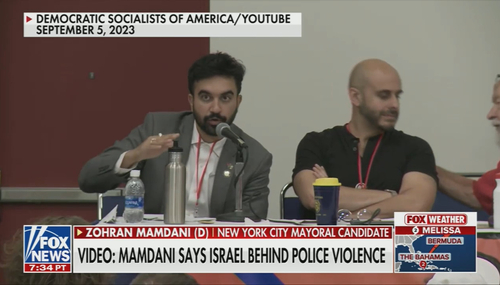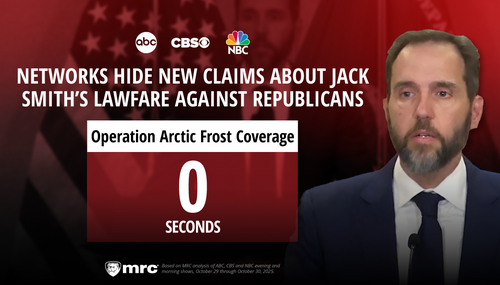 In seven days, the Washington Post:
In seven days, the Washington Post: - Ran 11 articles related to D.C.'s new law allowing same-sex marriage.
- Devoted 543 inches of column space to the ruling - equal to nearly four full pages.
- Printed 14 photos of gay celebrations, including a prominent one of two men kissing.
- Quoted supporters 11 times more often than opponents - 67 to 6.
- Repeatedly compared gay marriage to the historic civil rights movement.
Nobody can accuse The Washington Post of being objective when it came to covering the District of Columbia's decision to legalize same-sex marriage. The Post has reported on the event with a celebratory zeal more appropriate to The Advocate or The Blade.
The Post ran 11 stories in the seven days after March 3, the day after same-sex couples could begin applying for marriage licenses. The stories contained 67 quotes from gays, lesbians and activists, and only six who expressed opposition to the new law.
Post editors devoted nearly 543 inches of print-edition space to celebrating the changed marriage laws in D.C. That's almost four full newspaper pages - or nearly half of a weekday Style section - set aside specifically for this topic.
The tenor of stories ranged from practically giddy celebration to lament-laden over the lack of federal benefits available to same-sex couples, with some making the now common comparisons of same-sex marriage to interracial marriage.
And let's not forget the pictures. The March 4 issue featured a color photo of two gay men kissing each other, prominently placed on the front page above the fold, and caused so many complaints that the paper's ombudsman had to address it in March 9 blog post on its Web site, where he predictably defended it.
"News photos capture reality. And the prominent display reflects the historic significance of what was occurring. The recent D.C. Council decision to approve same-sex marriage was the culmination of a decades-long gay rights fight for equality," Andrew Alexander argued. "Same-sex marriage is now legal in the District. The photo of Ames and Ariga kissing simply showed joy that would be exhibited by any couple planning to wed - especially a couple who previously had been denied the legal right to marry."
The Post's Robert McCartney compared gay activist Frank Kameny to Thomas Jefferson and John Adams in his March 7 column, and a page-one March 4 celebratory article noted the "spontaneous applause and cheers" that broke out after the first same-sex couple applied for a marriage license.
Writer Joe Davidson, however, used the occasion to complain about the lack of federal benefits available to same-sex couples. He compared the federal government to "an uninvited uncle" in his March 9 "Federal Diary." Entitled "Uncle Sam has no wedding gift for this couple," Davidson focused on lesbians Lorilyn "Candy" Holmes and Darlene Garner who planned to get married. Holmes works for the Government Accountability Office.
"While Sam provides a nice package of benefits that cover spouses of this staff members, he's not going to give that wedding gift to Holmes, who has served him for 33 years, and Garner," lamented Davidson.
Holmes testified last July in favor of House legislation that would allow same-sex partners of federal employees to receive benefits.
"It is disturbing and demoralizing to be deemed a second-class citizen and worker," her testimony stated, according to Davidson. "And to be told I cannot through unfair policies and unjust practices that I can cannot enjoy the benefits of my labor on an equal footing with my opposite-gender counterparts."
A March 8 article by Michael Laris related the struggles four different same-sex couples faced with a lack of federal benefits.
Laris detailed the benefits unavailable to couple Jose Dominguez and Make Thomas, identified as a researcher at the Department of Veterans Affairs. "They won't share numerous federal benefits offered to married couples, they will still have to file federal taxes separately and their marriage won't be recognized outside a handful of states."
No counterpoint was provided in either Davidson's article or Laris's.
Post reporters hit another point in its coverage - that same-sex marriage is good for the economy.
In the March 10 article, "For District, wedding bells ring ka-ching," reporter Ylan Q. Mui detailed the lucrative field of same-sex weddings using research from the Williams Institute that found legalizing same-sex marriage could produce 700 jobs and an estimated $52.2 million revenue bump to the local economy within the next three years.
Mui somehow failed to note that according to its Web site, the Institute is a think-tank that "advances sexual orientation law and public policy through rigorous, independent research and scholarship, and disseminates it to judges, legislators, policymakers, media and the public." The Institute has been cited by media before in making an economic case for gay marriage, but its numbers don't withstand scrutiny.
As further evidence, Mui cited the $75,000 June wedding that Georgetown residents Christopher Cahill and Richard Marshall are planning and highlighted local businesses trying to cash in on the new law.
In an earlier March 7 Style section article, gay wedding planner Don Gillin attempted to portray same-sex couples as completely normal. "Getting into the business," wrote reporter Ellen McCarthy, "he expected gay weddings to be less traditional than straight weddings and perhaps a bit more ‘over the top. Instead, he's finding that clients want ‘exactly what everyone else has had ... They want it to be really classic.'" McCarthy also pushed the notion that same-sex marriage is good for the economy by including the $52.2 million stat from the Williams Institute in her article.
Of course, the Post could not cover same-sex marriage without comparing homosexuality to race, partly because people like D.C. mayor Adrian Fenty used the comparison. Reporters Ann E. Marimow and Keith L. Alexander noted on March 10 that the mayor told couples the weddings "were a great step forward for equality and for our city that has always been a standard-bearer for treating people equally and justly."
Reporter Michael Laris included the comparison used by one person featured in his March 9 article, Dominic Russoli, who explained that gay rights will come in increments. Russoli told Laris, "The 1964 civil rights legislation didn't start in one place. It didn't start as a movement with [President Lyndon B.] Johnson saying, ‘Yeah, we want to do this."
The Post took the "civil rights' cue and ran with it. In the March 9 Style section feature about lesbians Angelisa Young and Sinjoyla Townsend, "Young and Townsend don't know why anyone would want to read about them," reported Monica Hesse. "They're boring people," she claimed, listing various ways that make appear to be no different then any other couple.
But Hesse had her own reason: "Maybe Mildred and Richard Loving, the Virginia couple whose marriage ultimately ended anti-miscegenation laws in 1967 also thought they were boring ... Maybe someone suggests to Young and Townsend, their lives will become part of historical record."
As was typical in the coverage, no counterpoint was offered by the Post to refute the notion that gay rights and civil rights are equal.




